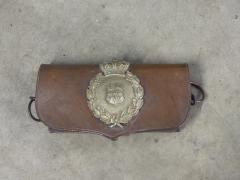Eton College formed its own Rifle Volunteer Corps in January 1860 and was reviewed by Queen Victoria and Prince Albert in Windsor Home Park in November 1861, this the latter’s last public appearance before his death. The 8th Bucks (Eton College) RVC was only officially formed in May 1867 with an attached cadet corps from August 1868. A rifle range was shared with the 5th Bucks (Slough) RVC at Chalvey and a drill hall was built in Eton Common Lane in 1879. The Eton boys also had their own field days, as at Hughenden in November 1871, as well as participating in civic events such as the dedication of Burnham Beeches in 1883. With the consolidation of the 1st Bucks Rifle Volunteers in 1875, the 2nd Bucks (Eton College) Rifle Volunteers had its first officers gazetted in June 1878. It became the 4th (Eton College) Volunteer Battalion, Oxfordshire Light Infantry in 1889, but was once more designated the 2nd Bucks (Eton College) Volunteer Rifle Corps in January 1902.
Under the Haldane reforms that established the Territorial Force, the Eton College boys were transferred to the Officers’ Training Corps (Junior Division) as the Eton College OTC on 25 September 1908. Unusually, since the Eton corps had always carried Colours, it was permitted to continue to do so by King George V in 1911: he presented new Colours in 1930. OTCs were not administered by the new County Territorial Associations but direct by the War Office with grants based on efficiency: £2 per cadet in the Senior Division based in universities and £1 in the Junior Division if 50 per cent attended camp. Those in the Junior Division could attain ‘Certificate A’, qualifying them for commissions in the Special Reserve and Territorial Force with reduced probation and no initial examination. During the Great War, 1,157 Old Etonians (masters and boys) were killed on active service from 5,560 who served with the armed forces.
